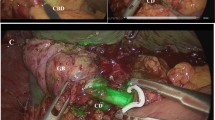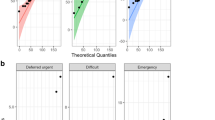Abstract
Background
Intraoperative cholangiography (IOC) is the current gold standard for biliary imaging during laparoscopic cholecystectomy (LC). However, utilization of IOC remains low. Near-infrared fluorescence cholangiography (NIRF-C) is a novel, noninvasive method for real-time, intraoperative biliary mapping. Our aims were to assess the safety and efficacy of NIRF-C for identification of biliary anatomy during LC.
Methods
Patients were administered indocyanine green (ICG) prior to surgery. NIRF-C was used to identify extrahepatic biliary structures before and after partial and complete dissection of Calot’s triangle. Routine IOC was performed in each case. Identification of biliary structures using NIRF-C and IOC, and time required to complete each procedure were collected.
Results
Eighty-two patients underwent elective LC with NIRF-C and IOC. Mean age and body mass index (BMI) were 42.6 ± 13.7 years and 31.5 ± 8.2 kg/m2, respectively. ICG was administered 73.8 ± 26.4 min prior to incision. NIRF-C was significantly faster than IOC (1.9 ± 1.7 vs. 11.8 ± 5.3 min, p < 0.001). IOC was unobtainable in 20 (24.4 %) patients while NIRF-C did not visualize biliary structures in 4 (4.9 %) patients. After complete dissection, the rates of visualization of the cystic duct, common bile duct, and common hepatic duct using NIRF-C were 95.1, 76.8, and 69.5 %, respectively, compared to 72.0, 75.6, and 74.3 % for IOC. In 20 patients where IOC could not be obtained, NIRF-C successfully identified biliary structures in 80 % of the cases. Higher BMI was not a deterrent to visualization of anatomy with NIRF-C. No adverse events were observed with NIRF-C.
Conclusions
NIRF-C is a safe and effective alternative to IOC for imaging extrahepatic biliary structures during LC. This technique should be evaluated further under a variety of acute and chronic gallbladder inflammatory conditions to determine its usefulness in biliary ductal identification.


Similar content being viewed by others
References
Flum DR, Dellinger EP, Cheadle A, Chan L, Koepsell T (2003) Intraoperative cholangiography and risk of common bile duct injury during cholecystectomy. JAMA 289:1639–1644
Waage A, Nilsson M (2006) Iatrogenic bile duct injury: a population-based study of 152 776 cholecystectomies in the Swedish Inpatient Registry. Arch Surg 141:1207–1213
Nuzzo G, Giuliante F, Giovannini I, Ardito F, D’Acapito F, Vellone M, Murazio M, Capelli G (2005) Bile duct injury during laparoscopic cholecystectomy: results of an Italian national survey on 56 591 cholecystectomies. Arch Surg 140:986–992
Flum DR, Cheadle A, Prela C, Dellinger EP, Chan L (2003) Bile duct injury during cholecystectomy and survival in medicare beneficiaries. JAMA 290:2168–2173
Adamsen S, Hansen OH, Funch-Jensen P, Schulze S, Stage JG, Wara P (1997) Bile duct injury during laparoscopic cholecystectomy: a prospective nationwide series. J Am Coll Surg 184:571–578
Olsen D (1997) Bile duct injuries during laparoscopic cholecystectomy. Surg Endosc 11:133–138
Hugh TB (2002) New strategies to prevent laparoscopic bile duct injury–surgeons can learn from pilots. Surgery 132:826–835
Archer SB, Brown DW, Smith CD, Branum GD, Hunter JG (2001) Bile duct injury during laparoscopic cholecystectomy: results of a national survey. Ann Surg 234:549–558
Francoeur JR, Wiseman K, Buczkowski AK, Chung SW, Scudamore CH (2003) Surgeons’ anonymous response after bile duct injury during cholecystectomy. Am J Surg 185:468–475
Khan OA, Balaji S, Branagan G, Bennett DH, Davies N (2011) Randomized clinical trial of routine on-table cholangiography during laparoscopic cholecystectomy. Br J Surg 98:362–367
Buddingh KT, Nieuwenhuijs VB, van Buuren L, Hulscher JB, de Jong JS, van Dam GM (2011) Intraoperative assessment of biliary anatomy for prevention of bile duct injury: a review of current and future patient safety interventions. Surg Endosc 25:2449–2461
Cherrick GR, Stein SW, Leevy CM, Davidson CS (1960) Indocyanine green: observations on its physical properties, plasma decay, and hepatic extraction. J Clin Invest 39:592–600
Mordon S, Devoisselle JM, Soulie-Begu S, Desmettre T (1998) Indocyanine green: physicochemical factors affecting its fluorescence in vivo. Microvasc Res 55:146–152
Ishizawa T, Bandai Y, Ijichi M, Kaneko J, Hasegawa K, Kokudo N (2010) Fluorescent cholangiography illuminating the biliary tree during laparoscopic cholecystectomy. Br J Surg 97:1369–1377
Schols RM, Bouvy ND, Masclee AA, van Dam RM, Dejong CH, Stassen LP (2013) Fluorescence cholangiography during laparoscopic cholecystectomy: a feasibility study on early biliary tract delineation. Surg Endosc 27:1530–1536
Vettoretto N, Saronni C, Harbi A, Balestra L, Taglietti L, Giovanetti M (2011) Critical view of safety during laparoscopic cholecystectomy. JSLS 15:322–325
Boerma D, Rauws EA, Keulemans YC, Bergman JJ, Obertop H, Huibregtse K, Gouma DJ (2001) Impaired quality of life 5 years after bile duct injury during laparoscopic cholecystectomy: a prospective analysis. Ann Surg 234:750–757
Cannon RM, Brock G, Buell JF (2011) A novel classification system to address financial impact and referral decisions for bile duct injury in laparoscopic cholecystectomy. HPB Surg 2011:371245
Massarweh NN, Flum DR (2007) Role of intraoperative cholangiography in avoiding bile duct injury. J Am Coll Surg 204:656–664
Kern KA (1995) An overview of 711 general surgery liability cases. The anatomy of surgical malpractice claims. Bull Am Coll Surg 80:34–49
Flum DR, Koepsell T, Heagerty P, Sinanan M, Dellinger EP (2001) Common bile duct injury during laparoscopic cholecystectomy and the use of intraoperative cholangiography: adverse outcome or preventable error? Arch Surg 136:1287–1292
Fletcher DR, Hobbs MS, Tan P, Valinsky LJ, Hockey RL, Pikora TJ, Knuiman MW, Sheiner HJ, Edis A (1999) Complications of cholecystectomy: risks of the laparoscopic approach and protective effects of operative cholangiography: a population-based study. Ann Surg 229:449–457
Flum DR, Flowers C, Veenstra DL (2003) A cost-effectiveness analysis of intraoperative cholangiography in the prevention of bile duct injury during laparoscopic cholecystectomy. J Am Coll Surg 196:385–393
Ragulin-Coyne E, Witkowski ER, Chau Z, Ng SC, Santry HP, Callery MP, Shah SA, Tseng JF (2013) Is routine intraoperative cholangiogram necessary in the twenty-first century? A national view. J Gastrointest Surg 17:434–442
Ishizawa T, Tamura S, Masuda K, Aoki T, Hasegawa K, Imamura H, Beck Y, Kokudo N (2009) Intraoperative fluorescent cholangiography using indocyanine green: a biliary road map for safe surgery. J Am Coll Surg 208:e1–e4
Buchs NC, Hagen ME, Pugin F, Volonte F, Bucher P, Schiffer E, Morel P (2012) Intra-operative fluorescent cholangiography using indocyanin green during robotic single site cholecystectomy. Int J Med Robot 8(4):436–440
Spinoglio G, Priora F, Bianchi PP, Lucido FS, Licciardello A, Maglione V, Grosso F, Quarati R, Ravazzoni F, Lenti LM (2013) Real-time near-infrared (NIR) fluorescent cholangiography in single-site robotic cholecystectomy (SSRC): a single-institutional prospective study. Surg Endosc 27:2156–2162
Buchs NC, Pugin F, Azagury DE, Jung M, Volonte F, Hagen ME, Morel P (2013) Real-time near-infrared fluorescent cholangiography could shorten operative time during robotic single-site cholecystectomy. Surg Endosc 27:3897–3901
Livingston EH, Miller JA, Coan B, Rege RV (2007) Costs and utilization of intraoperative cholangiography. J Gastrointest Surg 11:1162–1167
Dip FD, Asbun D, Rosales-Velderrain A, Menzo EL, Simpfendorfer CH, Szomstein S, Rosenthal RJ (2014) Cost analysis and effectiveness comparing the routine use of intraoperative fluorescent cholangiography with fluoroscopic cholangiogram in patients undergoing laparoscopic cholecystectomy. Surg Endosc Jan 11 (Epub ahead of print). doi:10.1007/s00464-013-3394-52014
Kim S, Lim YT, Soltesz EG, De Grand AM, Lee J, Nakayama A, Parker JA, Mihaljevic T, Laurence RG, Dor DM et al (2004) Near-infrared fluorescent type II quantum dots for sentinel lymph node mapping. Nat Biotechnol 22:93–97
Speich R, Saesseli B, Hoffmann U, Neftel KA, Reichen J (1988) Anaphylactoid reactions after indocyanine-green administration. Ann Intern Med 109:345–346
Mitsuhashi N, Kimura F, Shimizu H, Imamaki M, Yoshidome H, Ohtsuka M, Kato A, Yoshitomi H, Nozawa S, Furukawa K et al (2008) Usefulness of intraoperative fluorescence imaging to evaluate local anatomy in hepatobiliary surgery. J Hepatobiliary Pancreat Surg 15:508–514
Debru E, Dawson A, Leibman S, Richardson M, Glen L, Hollinshead J, Falk GL (2005) Does routine intraoperative cholangiography prevent bile duct transection? Surg Endosc 19:589–593
Acknowledgments
Special thanks to Rebecca Dettorre, MA, CCRC, and Andrew Suzo, BS, clinical research coordinators, for assisting with patient consent and data collection. We would like to thank the Foundation for Surgical Fellowship for support of Dr. Chaudhry. We would like to acknowledge protocol development assistance we received from the Center for Clinical and Translational Science (CCTS) at The Ohio State University, NIH Award UL1TR001070. This study was funded by a grant from SAGES and an in-kind device grant from Stryker.
Disclosures
Dr. Melvin is a consultant for Stryker. Dr. Narula obtained a grant in the form of an in-kind investigational device loan from Stryker in order to conduct this study. Abdel-Rasoul, and Drs. Osayi, Wendling, Drosdeck, Chaudhry, Perry, Noria, Mikami, Needleman, Muscarella, and Hazey have no conflicts of interest or financial ties to disclose.
Author information
Authors and Affiliations
Corresponding author
Rights and permissions
About this article
Cite this article
Osayi, S.N., Wendling, M.R., Drosdeck, J.M. et al. Near-infrared fluorescent cholangiography facilitates identification of biliary anatomy during laparoscopic cholecystectomy. Surg Endosc 29, 368–375 (2015). https://doi.org/10.1007/s00464-014-3677-5
Received:
Accepted:
Published:
Issue Date:
DOI: https://doi.org/10.1007/s00464-014-3677-5




